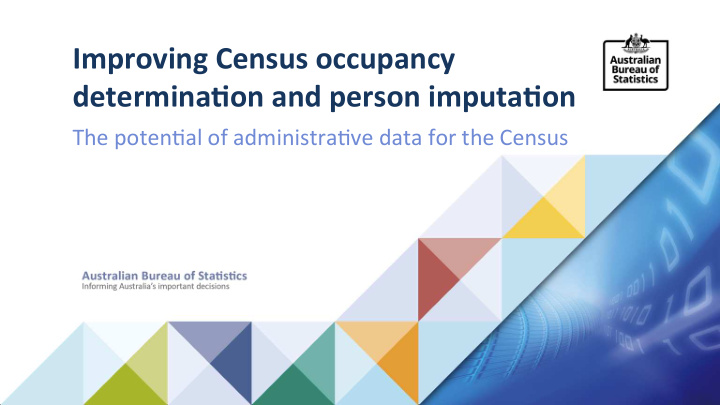



Improving Census occupancy determina4on and person imputa4on The poten)al of administra)ve data for the Census
What is the Census? The Census of Popula)on and Housing is a rich snapshot of all people in the country on Census night and is the leading source of informa)on for small popula)on groups and areas. The Census underpins data that informs the planning and delivery of Government and community services, business decisions and is a key source for important academic research. 2 8/07/19
Administra4ve data research for the 2021 Census The ABS is researching the poten)al of admin data to: Improve Census data quality Add new informa)on to the Census Reduce the cost and burden of the Census 3 8/07/19
Administra4ve data research for the 2021 Census This research inves)gates how we could improve the Census count by using administra)ve data to: 1. Improve our occupancy determina)on 2. Improve our imputa)on for non-responding dwellings 4 8/07/19
Public Trust and Privacy Building public trust and ensuring privacy are important pieces of this work The 2021 Census will be conduc)ng a Privacy Impact Assessment which will address any plans to use administra)ve data such as those discussed here We will be upda)ng our website as we progress (see links at end of presenta)on) 5 8/07/19
What are occupancy and imputa4on? Produce output data Impute Consider Determine dwellings occupancy Inform response rate 6 8/07/19
What happened in 2016? The Census Independent Panel said that the quality of the 2016 Census was comparable to that of 2011 While the quality was high overall, there were… – Too many dwellings determined to be occupied – Too many people imputed – Not the right distribu)on of people imputed Response rate was “actually” higher than reported 7 8/07/19
Data sources Census and related data – e.g. 2016 Census and Post Enumera)on Survey Government data – e.g. Taxa)on, Social services and Medicare enrolments Other data – e.g. rental data, u)lity connec)ons 8 8/07/19
1. Occupancy determina4on Historically, occupancy determina)on has relied on intelligence from field staff As our popula)on changes (accommoda)on types, increasing mobility), the Census moves online, and the number of field staff reduces, determining occupancy becomes more challenging Admin data provides another source of informa)on to provide insight into how likely a dwelling is to have been occupied at the )me of Census 9 8/07/19
1. Occupancy determina4on Admin data enables us to produce a score (between 0 and 1) of how likely it is that a dwelling was occupied at the )me of Census Inform field opera)ons e.g. 0.8 Improve output data 10 8/07/19
1. Occupancy determina4on The Post Enumera)on Survey (PES) es)mated that we incorrectly determined 44% of non-responding dwellings to be occupied (represen)ng about 500,000 people) This hasn’t affected our popula)on es)mates because we adjust for any over or under-coun)ng using the PES Most small area Census counts aren’t much affected either, but a number of areas, par)cularly with secure apartments, have higher counts than they should 11 8/07/19
1. Occupancy determina4on We can reduce the number of dwellings we determine as occupied by any amount we want by sedng a par)cular threshold for the occupancy score A key methodological ques)on we are working through is what threshold to use 12 8/07/19
1. Occupancy determina4on Occupancy Reduc)on in imputed Es)mated 2016 Es)mated 2016 net score dwellings rela)ve to response rate undercount threshold census 2016 (2016 response rate (2016 net undercount was 94.8%) was 1%) 0.5 24% 95.8 % 2% 0.74 44% 96.7 % 3% 13 8/07/19
1. Occupancy determina4on 14 8/07/19
2. Imputa4on for non-responding dwellings Historically, we have used a hot-decking, nearest neighbour donor approach 15 8/07/19
2. Imputa4on for non-responding dwellings This relies on the assump)on that the responding popula)on is the same (sta)s)cally) as the non- responding popula)on Admin data now suggests that the distribu)on of the responding popula)on is different to that of the non- responding popula)on 16 8/07/19
2. Imputa4on for non-responding dwellings 17 8/07/19
2. Imputa4on for non-responding dwellings In 2016, the Post Enumera)on Survey indicated that we didn’t impute the right distribu)on of people. Specifically, not enough young people and not enough males By choosing hot-decking donor households based on administra)ve data variables, we can make the imputed popula)on closer to reality 18 8/07/19
2. Imputa4on for non-responding dwellings ≈ 19 8/07/19
2. Imputa4on for non-responding dwellings 20 8/07/19
2. Imputa4on for non-responding dwellings 21 8/07/19
Research informa4on on our website Administra)ve data research for the 2021 Census Can administra)ve data help to improve the Census count? 22 8/07/19
Ques4ons?
Recommend
More recommend